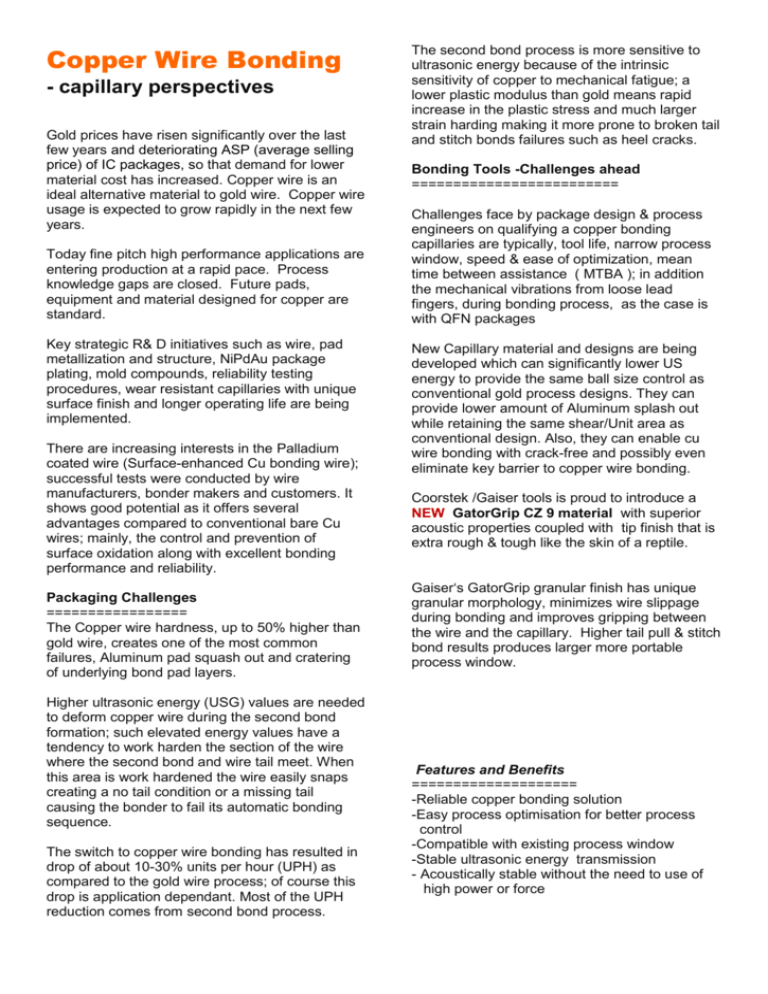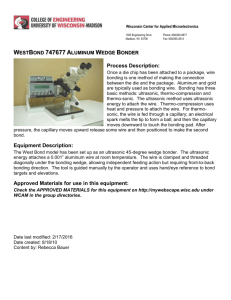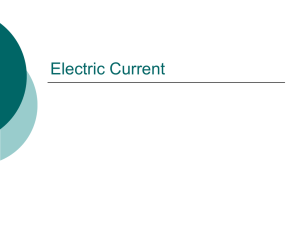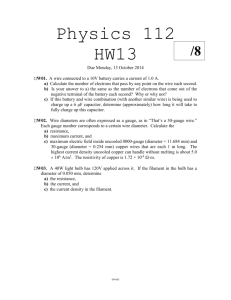Copper Wire Bonding - capillary perspectives Gold prices have risen
advertisement

Copper Wire Bonding - capillary perspectives Gold prices have risen significantly over the last few years and deteriorating ASP (average selling price) of IC packages, so that demand for lower material cost has increased. Copper wire is an ideal alternative material to gold wire. Copper wire usage is expected to grow rapidly in the next few years. Today fine pitch high performance applications are entering production at a rapid pace. Process knowledge gaps are closed. Future pads, equipment and material designed for copper are standard. Key strategic R& D initiatives such as wire, pad metallization and structure, NiPdAu package plating, mold compounds, reliability testing procedures, wear resistant capillaries with unique surface finish and longer operating life are being implemented. There are increasing interests in the Palladium coated wire (Surface-enhanced Cu bonding wire); successful tests were conducted by wire manufacturers, bonder makers and customers. It shows good potential as it offers several advantages compared to conventional bare Cu wires; mainly, the control and prevention of surface oxidation along with excellent bonding performance and reliability. Packaging Challenges ================= The Copper wire hardness, up to 50% higher than gold wire, creates one of the most common failures, Aluminum pad squash out and cratering of underlying bond pad layers. Higher ultrasonic energy (USG) values are needed to deform copper wire during the second bond formation; such elevated energy values have a tendency to work harden the section of the wire where the second bond and wire tail meet. When this area is work hardened the wire easily snaps creating a no tail condition or a missing tail causing the bonder to fail its automatic bonding sequence. The switch to copper wire bonding has resulted in drop of about 10-30% units per hour (UPH) as compared to the gold wire process; of course this drop is application dependant. Most of the UPH reduction comes from second bond process. The second bond process is more sensitive to ultrasonic energy because of the intrinsic sensitivity of copper to mechanical fatigue; a lower plastic modulus than gold means rapid increase in the plastic stress and much larger strain harding making it more prone to broken tail and stitch bonds failures such as heel cracks. Bonding Tools -Challenges ahead ========================= Challenges face by package design & process engineers on qualifying a copper bonding capillaries are typically, tool life, narrow process window, speed & ease of optimization, mean time between assistance ( MTBA ); in addition the mechanical vibrations from loose lead fingers, during bonding process, as the case is with QFN packages New Capillary material and designs are being developed which can significantly lower US energy to provide the same ball size control as conventional gold process designs. They can provide lower amount of Aluminum splash out while retaining the same shear/Unit area as conventional design. Also, they can enable cu wire bonding with crack-free and possibly even eliminate key barrier to copper wire bonding. Coorstek /Gaiser tools is proud to introduce a NEW GatorGrip CZ 9 material with superior acoustic properties coupled with tip finish that is extra rough & tough like the skin of a reptile. Gaiser‘s GatorGrip granular finish has unique granular morphology, minimizes wire slippage during bonding and improves gripping between the wire and the capillary. Higher tail pull & stitch bond results produces larger more portable process window. Features and Benefits ==================== -Reliable copper bonding solution -Easy process optimisation for better process control -Compatible with existing process window -Stable ultrasonic energy transmission - Acoustically stable without the need to use of high power or force Acoustics advantages ==================== - A well-balanced ceramic material mixture & composition for consistent acoustical performance - Lower attenuation of energy transfer during the bond process - Higher efficiency of energy transferred to the interface of the bond - Requires less ultrasonic power therefore reducing stress at neck and heel areas of the bond Percentage Loss Energy Loss by Attenuation 40 35 30 25 20 15 10 5 0 1 CompetitorA CompetitorB CZ9-GGD Mechanical Advantages =================== Gaiser’s new material CZ9 coupled with a tip finish that is extra rough & tough like the skin of a reptile, 1) Greatly increases the mechanical coupling between the capillary & the copper wire, 2) Provides a good anchoring of the wire to prevent micro-sliding and to yield a high strength bond. 3) Each protruding grain acts as ultrasonic concentrators achieving a more efficient transfer of energy 4) The ceramic blend CZ9 produces an acoustically stable tool without the need for high ultrasonic power 5) A dense surface finish makes it less prone to built-up and accumulation of foreign debrises 6) Greatly improves stitch strength, short-tailing and adhesion with better Cu remains after stitch pull. Moving ahead ============= By keeping and maintaining the proper controls procedures, copper wire bonding can work quite well. Its cost justifies the efforts; however, it must be done with care and attention to details. A well –thoughtout & designed copper bonding process flow will be beneficial to the process engineers and their end- customer allowing the industry to continue its cost down strategy throughout the manufacturing cycle. The one issue still facing the successful implementation of copper wire is still corrosion. Lifted ball bonds are still the major failure mode seen during reliability testing. Some of the key success factors are : careful selection of all materials is critical; handling and storage of work-in-process must be re-examined and tuned accordingly; encapsulant must be of the halogen-free variety ; post-mold operations must not damage the interface of compoundsubstrate or lead frame or expose it to halogen bearing materials. As the technology matures , process knowledge gaps are closing up, better understanding of the copper capabilities and limitations will help dictate its place in the industry as to the best suited applications. Copper may not work for all semiconductor applications but it can definitely help support many areas where cost and performance define a product









